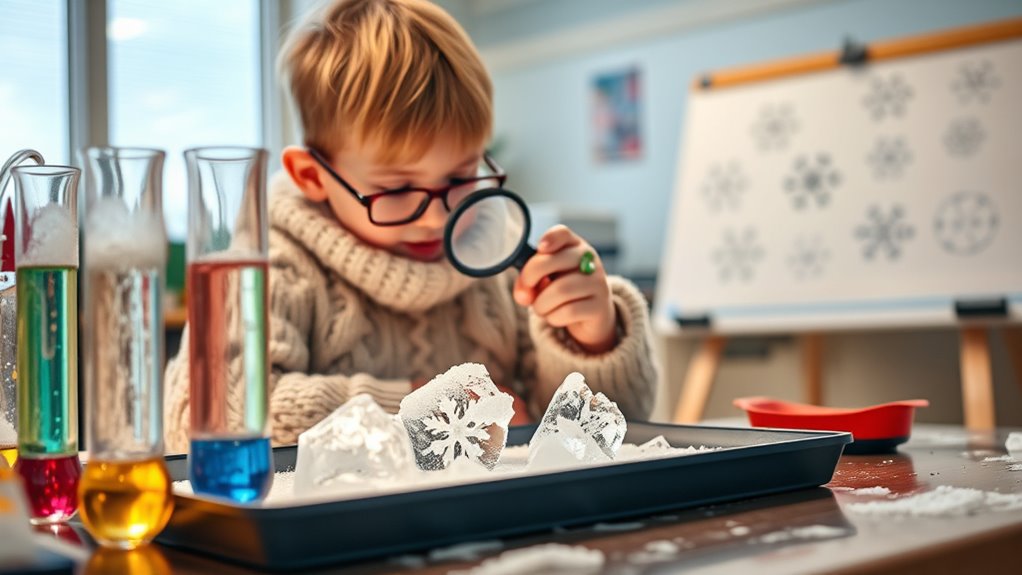Building STEM skills with winter science experiments is a fun way to explore snow, ice, and cold temperatures firsthand. You’ll learn about physical properties, heat transfer, and melting points through hands-on activities like testing how different salts affect ice or investigating snow’s texture. These experiments boost your observation, problem-solving, and scientific thinking. Keep exploring, and you’ll discover how winter science connects to real-world applications like road safety and winter gear design.
Key Takeaways
- Engages learners in hands-on activities that develop critical thinking and problem-solving skills through winter-themed experiments.
- Demonstrates physical science concepts like heat transfer and melting points using snow, ice, and salts.
- Encourages observation, hypothesis formulation, and data analysis in real-world winter scenarios.
- Promotes safety awareness and proper scientific procedures during outdoor and indoor experiments.
- Connects scientific principles to practical applications such as road safety and winter gear design, strengthening STEM understanding.

Winter is the perfect time to explore STEM skills through fun and engaging science experiments. As the cold weather sets in, it offers a unique opportunity to investigate how winter weather impacts the world around you. Whether you’re interested in understanding the properties of snow and ice or learning about the science behind freezing temperatures, winter provides a rich environment for hands-on learning. However, while diving into these experiments, it’s essential to prioritize science safety to guarantee everyone stays safe and injury-free. Wearing appropriate clothing, working in well-ventilated areas, and using age-appropriate materials are indispensable steps to keep your experiments both fun and safe.
Winter offers the perfect opportunity for fun, safe, hands-on STEM experiments exploring snow, ice, and freezing temperatures.
When working with winter weather elements like snow and ice, you’ll quickly learn about their physical properties. For example, you can test how different substances melt snow faster or slower, which teaches about heat transfer and the effects of salt or sugar on melting points. These experiments not only help you grasp essential scientific concepts but also highlight real-world applications, such as road safety during winter storms. Remember, safety always comes first—avoid ingesting or inhaling any experiment materials, and supervise children closely to prevent accidents.
Incorporating science safety into your winter experiments is simple yet indispensable. Always wear gloves when handling ice or snow to prevent frostbite or skin irritation, especially if working outdoors for extended periods. Use goggles to shield your eyes from splashes or flying debris when melting or breaking ice. If you’re experimenting indoors, guarantee good ventilation, especially if you’re heating substances or using chemicals like alcohol or other solvents in your experiments. Keep a first aid kit nearby, and know how to handle minor injuries, like cuts from ice or burns from heated materials. Additionally, exploring the role of temperature control in projectors can help understand how precise environmental conditions influence scientific devices and experiments.
Frequently Asked Questions
How Can I Make Winter Science Experiments Safe for Young Children?
To keep winter science experiments safe for young children, you should conduct a thorough risk assessment beforehand, identifying potential hazards like hot liquids or fragile materials. Always supervise closely, using clear supervision strategies such as constant eye contact and physical proximity. Use age-appropriate materials, provide safety gear like goggles, and keep a first aid kit nearby. These steps guarantee children explore and learn while staying safe during winter science activities.
What Are Some Budget-Friendly Materials for Winter STEM Activities?
You can use budget-friendly materials like DIY ice experiments with household items, such as salt, water, and food coloring. Recycled material projects, like plastic bottles or bottle caps, make great tools for winter STEM activities. These materials are inexpensive, readily available, and safe for kids. Plus, they encourage creativity and problem-solving, making your winter science experiments both fun and educational without breaking the bank.
How Do Winter Experiments Enhance Long-Term Scientific Understanding?
Cold weather might seem like a challenge, but it actually fuels your seasonal learning and deepens your scientific understanding. Winter experiments stick with you because they connect real-world conditions to core concepts, creating lasting impressions. As you explore snow crystallization or ice melting, you build a foundation for future curiosity. This hands-on engagement makes science relevant, memorable, and essential for long-term growth, turning chilly days into powerful learning opportunities.
Can Winter Science Experiments Be Adapted for Classroom Settings?
Yes, you can adapt winter science experiments for classroom settings by incorporating outdoor activities and home modifications. Encourage students to observe snow and ice, conduct experiments outside, and record their findings. Bring the outdoors in with snow-inspired projects or use everyday home items for experiments. These approaches make learning engaging, practical, and accessible, helping students develop essential STEM skills while enjoying the winter environment.
What Are the Best Ways to Document and Share Winter Science Projects?
Why not turn your winter science projects into digital masterpieces? You can document your experiments with photos, videos, and detailed notes, then showcase them in a digital portfolio—your personal science gallery. Don’t forget social media sharing; it’s perfect for celebrating your winter STEM wins with friends and fellow enthusiasts. With a little creativity, your projects become not just educational but also a winter wonderland of science on screens everywhere.
Conclusion
By trying these winter science experiments, you boost your STEM skills while having fun. Did you know that hands-on activities like these can improve problem-solving abilities by up to 40%? So, next time you’re stuck indoors, grab some supplies and explore the science of winter. Not only will you stay engaged, but you’ll also develop skills that could shape your future. Embrace the cold and turn it into a chance to learn and grow!









